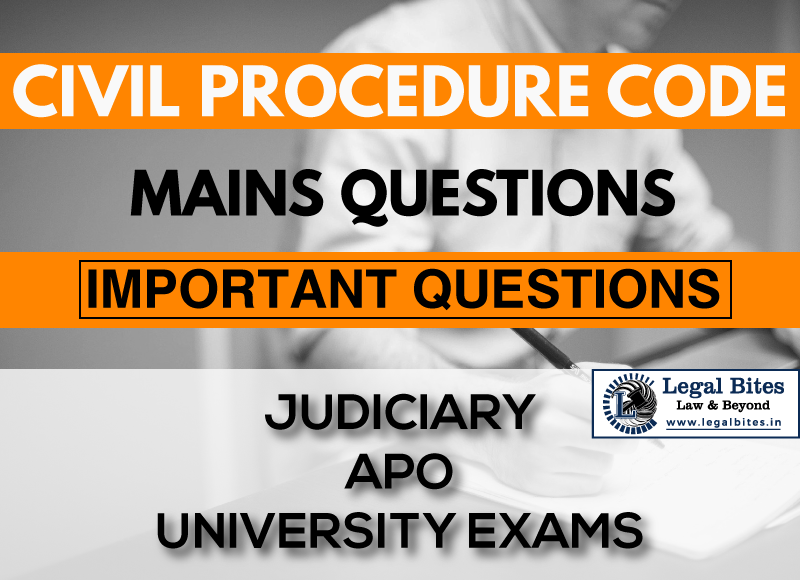Where the suit can be in the case where ‘A’ resides at Simla, 'B' at Kolkata and 'C' at Delhi, ‘A’, 'B’ and ‘C’ being together at Varanasi. ‘B’ and ‘C’ make a joint promissory note payable on demand and deliver it to ‘A’. A breach is made.
Question: Where the suit can be in the case where ‘A’ resides at Simla, ‘B’ at Kolkata and ‘C’ at Delhi, ‘A’, ‘B’ and ‘C’ being together at Varanasi. ‘B’ and ‘C’ make a joint promissory note payable on demand and deliver it to ‘A’. A breach is made. [WBJ 1993, BJS 1978, JKJ 2009, DJS 2006, HPJ… Read More »
;
Question: Where the suit can be in the case where ‘A’ resides at Simla, ‘B’ at Kolkata and ‘C’ at Delhi, ‘A’, ‘B’ and ‘C’ being together at Varanasi. ‘B’ and ‘C’ make a joint promissory note payable on demand and deliver it to ‘A’. A breach is made. [WBJ 1993, BJS 1978, JKJ 2009, DJS 2006, HPJ 2000] Find the answer to the mains question only on Legal Bites. [Where the suit can be in the case where ‘A’ resides at Simla,...
Question: Where the suit can be in the case where ‘A’ resides at Simla, ‘B’ at Kolkata and ‘C’ at Delhi, ‘A’, ‘B’ and ‘C’ being together at Varanasi. ‘B’ and ‘C’ make a joint promissory note payable on demand and deliver it to ‘A’. A breach is made. [WBJ 1993, BJS 1978, JKJ 2009, DJS 2006, HPJ 2000]
Find the answer to the mains question only on Legal Bites. [Where the suit can be in the case where ‘A’ resides at Simla, ‘B’ at Kolkata and ‘C’ at Delhi, ‘A’, ‘B’ and ‘C’ being together at Varanasi. ‘B’ and ‘C’ make a joint promissory note payable on demand and deliver it to ‘A’. A breach is made.]
Answer
This problem is based on Section 20 of The Code of Civil Procedure, 1908. Section 20 states that –
Other suits to be instituted where defendants reside or cause of action arises.
Subject to the limitations aforesaid, every suit shall be instituted in a Court within the local limits of whose jurisdiction
(a) the defendant, or each of the defendants where there are more than one, at the time of the commencement of the suit, actually and voluntarily resides, or carries on business, or personally works for gain; or
(b) any of the defendants, where there are more than one, at the time of the commencement of the suit, actually and voluntarily resides, or carries on business, or personally works for gain, provided that in such case either the leave of the Court is given, or the defendants who do not reside, or carry on business, or personally works for gain, as aforesaid, acquiesce in such institution; or
(c) The cause of action, wholly or in part, arises.
Section 20 on which this problem is based speaks when the case does not fall under Section 16 to 19 (the case is covered by section 20) then suit by the plaintiff may be instituted either in a court within the local limits of whose jurisdiction defendant resides/carries on business/personally works for gain or in a court within the local limits of whose jurisdiction cause of action wholly or partly arises.
Thus, in the given problem, the suit can be filed at Varanasi (where the cause of action arose), at Kolkata (Where B resides) or at Delhi (where C resides). There are two defendants namely ‘B’ and ‘C’. Thus, according to Section 20 (b) where A sues either at Kolkata or in Delhi, in each of these cases, if the non-resident defendant objects, the suit can not proceed without the leave of the court.
Important Mains Questions Series for Judiciary, APO & University Exams
- CPC Mains Questions Series: Important Questions Part – I of X
- CPC Mains Questions Series: Important Questions Part – II of X
- CPC Mains Questions Series: Important Questions Part – III of X
- CPC Mains Questions Series: Important Questions Part – IV of X
- CPC Mains Questions Series: Important Questions Part – V of X
- CPC Mains Questions Series: Important Questions Part – VI of X
- CPC Mains Questions Series: Important Questions Part – VII of
- CPC Mains Questions Series: Important Questions Part – VIII of X
- CPC Mains Questions Series: Important Questions Part – IX of X
- CPC Mains Questions Series: Important Questions Part – X of X


